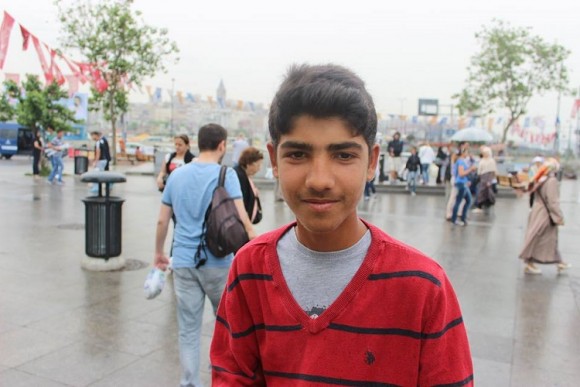 A Syrian refugee on the streets of Istanbul. Turkey is hosting more than 350,000 refugees from the conflict across its border. Image credit: Micheal Dean
A Syrian refugee on the streets of Istanbul. Turkey is hosting more than 350,000 refugees from the conflict across its border. Image credit: Micheal DeanThese are Syrians who have fled their country because of war and conflict, who prefer to stay outside the settlement camps where the majority of refugees live. As an African from a post-war region of Northern Uganda, and having witnessed the pain of conflict, I can connect with what the Syrian refugees are going through. Their survival on the streets is a clear indicator of a bad situation that has turned worse. This reminds me of my mother risking her life in order to bring us food from our abandoned, rebel-infested village in Gulu. I can see my family’s suffering all over again in the eyes of these Syrian women and children.
A shift in the media coverage of Syrian refugees
I recently interviewed Turkish citizens, international journalism students and Middle East academics on the coverage of refugees, after a conference on how the media reports conflicts. One issue they all raised is the media coverage of Syrians and to that effect, peace advocates are now calling for the institution of peace journalism training in a bid to improve refugee coverage.
Ali Karacan, for example, says local media are not reporting on the suffering of Syrian refugees.
“There are more media reports about Syrians in the international media than local media. Yet the locals, being closer, should offer more coverage on Syrian refugees in order to create room for dialogue and peacemaking,” he says.
“Some coverage seems to even label them as menacing, and this in no way helps the situation,” he adds.
“I believe more stories covering peace makers, people who are offering solutions to problems, could not only help the situation but entice more people to participate or empathise with the plight of the refugees, as well as the citizens of Turkey”.
Dr. Metin Ersoy, from the University of Eastern Mediterranean, says that the general tendency of Turkish media is problematic.
“At the beginning of the refugee movement, the Turkish media atmosphere was positive to this movement. Later on, and we do not know exactly when that changed the media coverage, it became more dramatic”.
According to Ersoy, the issues are covered with limited and essentially elite sources. “They cover any issues related with Syrian refugees, but journalists are not asking the ‘why’ question in order to investigate the conditions and problems the refugees are facing.”
The positive impact of a 'peace journalism' approach
Dr Metin says that the Turkish media should use more empathy as they report on Syrian refugees. He hailed World peace journalism trainer, Professor Steve Youngblood from the Centre for Global Peace Journalism at Park University, for doing a remarkable job with peace journalism training and mentoring in conflict affected countries, particularly on Syrian war victims.
For Dr Metin, Youngblood’s Peace Journalism project is a big contribution to Turkish media in terms of capacity building, and that it boosts the efforts of local peace organisations and institutions.
He says the media ought to cover the issues from a different point of view: “They need to give a stronger voice to those people for us to understand the situation.”
“The media should think about the consequences of their news reports and the effect it has on civilians,” he adds.
Nevertheless, on a positive note, there is still hope. Prof. Nilüfer Pembecioğlu of Istanbul University has launched a peace journalism training course, and her and Youngblood have extended the training to Adana University in Turkey.
A peace journalism approach can help stop bad situations from becoming worse. So providing formal training in it could help the media to create a peaceful society. We should encourage it at every opportunity.










